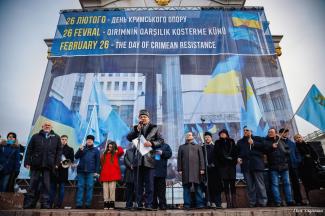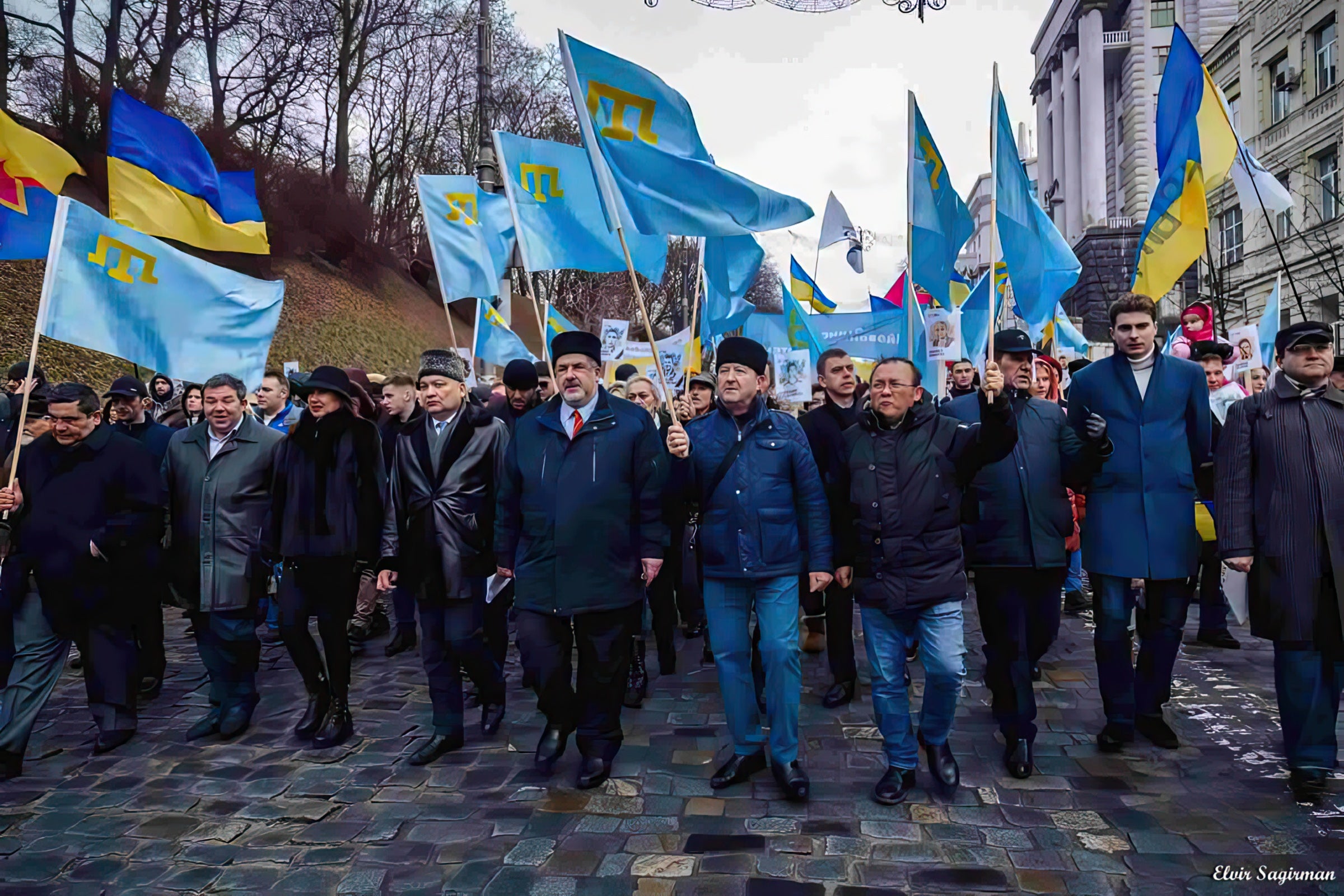
Crimean Tatars are the Indigenous Peoples of the Crimean peninsula. In the 15th century, they formed the Crimean Khanate, which was dismantled by the Russian Empire in 1783. The dispossession of Indigenous Peoples in Crimea from their land, followed by systematic policies of repression and assimilation, led the Crimean Tatars to become a minority in their homeland.
In 1944, 200,000 Crimean Tatars were forcibly resettled in Central Asia, the Urals, and Siberia; 30,000 died in the first six months. The information about the dead was hidden, so the Crimean Tatars were forced to conduct an independent census of survivors. According to the Crimean Tatar National Movement, nearly half of the total number of deportees died as a result of forced deportation.
After their deportation, everything connected with the Crimean Tatars was destroyed. Soviet forces resettled residents from Russia and Ukraine en masse, renamed authentic Crimean Tatar place names, falsified history, destroyed Crimean Tatar literature, and struck them from the ethnographic list of Peoples in the Soviet Union. Following a persistent, non-violent, 45-year struggle for their rights, the Crimean Tatars began to return to their historical homeland. However, upon returning, the authorities did not allow them to enter their traditional territories.
In 2014, the Russian Federation invaded Crimea, violating the UN Charter and Article 3 of the UN Declaration on the Rights of Indigenous Peoples. The occupiers began persecuting the Crimean Tatars with hate speech and violating their fundamental human rights and collective rights as Indigenous Peoples. To this day, the occupying administration regularly uses illegal detentions, arrests, and searches, fabricated administrative and criminal charges, threats, beatings, torture, abductions, murders, and illegal alienation of private property. Ukrainian law enforcement has ceased to function.
As a result, a gang calling themselves Self-Defense of Crimea, controlled by the Federal Security Service (FSB) of the Russian Federation, has brutally suppressed any dissent. Since 2014, 60 people have died, 28 of them Indigenous. Additionally, 21 people have been subjected to enforced disappearance, 15 of them representatives of the Crimean Tatars, including Ervin Ibragimov, a member of the Coordinating Council of the World Congress of Crimean Tatars. The occupiers are trying to discredit Indigenous people before the international community, presenting them as “terrorists” and “extremists.” Interrogations of relatives of political prisoners and activists of the Crimean Tatar national movement are also common.
In the newly occupied regions of Kherson and Zaporozhye, invaders have created more than 20 interrogation and torture sites. We know of such facilities in Genichesk, Nova Kakhovka, Kherson, and Melitopol, along with Basement 17 of the Genichesk school, where hundreds of people are kept for “re-education.” As of July 20, 2023, there were 175 political prisoners in Russian places of detention, 117 of whom are representatives of the Indigenous Crimean Tatars. Nariman Dzhelal, Deputy Chairman of the Mejlis of the Crimean Tatar people, has been imprisoned since 2021. In February 2023, political prisoner Dzhemil Gafarov died in prison. The occupiers have banned the only independent Crimean Tatar TV channel, ATR. Radio stations Meydan and Lider were searched, and the founder of the QHA news agency, Ismet Yuksel, was banned from entering Crimea, forcing these media outlets to leave Crimea. The websites of the Mejlis of the Crimean Tatar people and the Crimean Tatar Resource Center are also blocked.
Prior to the occupation, Crimean Tatars systematically held mass public actions observing the victims of the Crimean Tatar Genocide and celebrating the Day of the Crimean Tatar Flag, World Indigenous Peoples Day, and Human Rights. Day Since then, public events are forbidden.

Solidarity march with the Crimean Tatar people in Kyiv, Ukraine, in February 2017.
Traditional Governance
The Kurultai and the Mejlis are the Tatar democratic bodies. Kurultai is the highest representative body, elected in direct democratic elections. The Kurultai elects the Mejlis, a representative and executive body. In 1995, the Mejlis was recognized as an organization of Indigenous people and admitted to the work of the UN. By Decree of the President of Ukraine, dated May 18, 1999, the Mejlis was given the status of the Council of Representatives of the Crimean Tatar Peoples and is recognized as a representative institution of the Crimean Tatars in Ukraine’s legal code.
From the beginning of the Russian occupation, the Mejlis has been persecuted consistently for its non-violent upholding of the collective rights of the Crimean Tatars. In 2016, the Russian Supreme Court banned the Mejlis, declaring it an extremist organization. On April 19, 2017, the International Court of Justice issued a judgment regarding a complaint about a violation of the International Convention on the Elimination of All Forms of Racial Discrimination, ordering Russia to resume the activities of the Mejlis. However, the Russian Federation has not yet implemented this order, and the Mejlis remains limited in the implementation of its representative functions due to the threat of criminal liability. Criminal proceedings have been opened against a number of members of the Mejlis.
Language, Education, and Culture
The occupying administration has destroyed Tatar cultural heritage sites, including the world’s only example of Crimean Tatar palace architecture, the Khan’s Palace. Under the guise of restorations, excavations were carried out without the consent of Ukrainian or Mejlis authorities, and the artifacts were taken to Russia. Despite Crimean Tatar being one of the official State languages, there are no Crimean Tatar official pages of the websites of the occupying government, office work is carried out only in Russian, and people are forbidden to testify in their native language in courts. Cases of threats of dismissal of workers for communicating in their native language have also been recorded.
Prior to occupation, there were 15 schools and 384 classes instructed in the Crimean Tatar language. According to the data of the occupying government, there are seven schools remaining that teach in Crimean Tatar, and three with bilingual instruction in Russian and Crimean Tatar. Instruction in Crimean Tatar is allowed only at the request of parents via application, but school administrations routinely create obstacles in filing these applications or do not accept them. Attempts have been made to close schools that were teaching in Crimean Tatar in the village of Annovka and in the city of Stary Krym.
In the 2020-2021 academic year, out of 73,900 children studying in 554 schools, only 1,200 (1.6 percent) received instruction in Crimean Tatar. School administrators reprimand children for communicating in their native language, and raids are carried out to search for prohibited literature. FSB officers conduct “preventive” conversations with Crimean Tatar children and subject them to questioning to ascertain the attitudes of their families—specifically their likelihood of dissent.
Land Rights
On January 15, 2015, the Law of the Republic of Crimea on the Provision of Land Plots in State or Municipal Ownership and Some Issues of Land Relations was adopted. Issues remain unresolved with the registration of land for representatives of Indigenous people in the Simferopol region, Evpatoria, and Sudak, located on the southern coast of Crimea. Meanwhile, their land is being auctioned off. As part of the ongoing policy of replacing the population on the peninsula, Russian citizens are assisted in acquiring land and provided with preferential employment opportunities. Since the start of a full-scale aggression against Ukraine, the occupying administration has been distributing land plots to the Russian military.
In addition to depriving the Crimean Tatar people of the right to land, their inalienable right to resources and minerals in their territories is also being ignored. On November 17, 2019, the Mejlis adopted the Statement, “On Observance of the Inalienable Rights of the Indigenous Crimean Tatar People in the Conditions of the Temporary Occupation of Crimea by the Russian Federation.” However, the practice of using the resources and minerals of the Crimean peninsula without the Free, Prior and Informed Consent of the Mejlis continues. Tens of thousands of Crimean Tatars have been forced to leave their native land, and according to the Crimean Tatar Resource Center, about 1 million Russians were brought into the territory. In spite of these hardships, Crimean Tatars continue to fight, and never give up hope.
--Eskender Bariiev (Crimean Tatar) is Head of the Board of the Crimean Tatar Resource Center.
Top photo: Eskender Bariiev speaking at a rally for Crimean Tatars’ rights. All photos by Zarema Bariieva.
